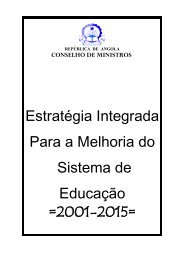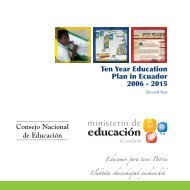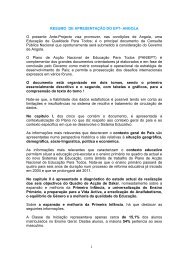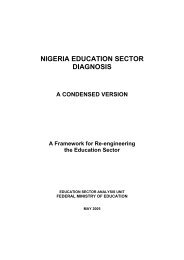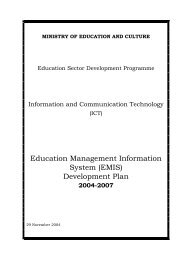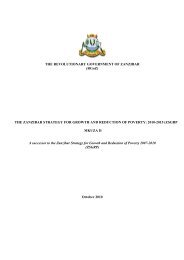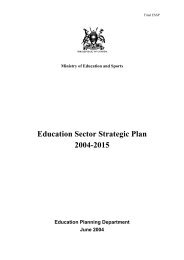- Page 1 and 2:
Ministère de l’Éducation Nation
- Page 3 and 4:
1.3.6 Un changement dans le calendr
- Page 5 and 6:
3.1.14 Modèles de salle de classe
- Page 7 and 8:
5.5.2 Introduction des Réformes da
- Page 9 and 10:
Liste des tableaux Tableau 1 : Nouv
- Page 11 and 12:
Liste des graphiques Graphique 1: P
- Page 13 and 14:
Liste des figures Figure 1 : Transi
- Page 15:
ENF Enseignant Non Fonctionnaire EP
- Page 18 and 19:
du financement public est utilisé
- Page 20 and 21:
Moins de la moitié de ceux qui com
- Page 22 and 23:
2.3. EQUITE S’il n’y a pas de d
- Page 24 and 25:
Ainsi, la restructuration des cycle
- Page 26 and 27:
EPT 2003-2007 Enseiggnement primair
- Page 28 and 29:
Le nouveau curriculum , ses objecti
- Page 30 and 31:
Et un cadre d’ actions est en cou
- Page 32 and 33:
1. Expansion. En 2015, plus de 700
- Page 34 and 35:
Niveau 10 Second Semestre Niveau 10
- Page 36 and 37:
des CE comprendront le travail de f
- Page 38 and 39:
cycle ; en effet, sans les connaiss
- Page 40 and 41:
Tableau 4: Résultats attendus par
- Page 42 and 43:
Cadre Politique Législation Coordi
- Page 44 and 45:
Ressources publiques et internes Re
- Page 46 and 47:
Graphique 2 : Évolution des besoin
- Page 48 and 49:
9. COORDINATION DES PARTENAIRES TEC
- Page 50 and 51:
1. ETATS DES LIEUX ET BILAN DU SECT
- Page 52 and 53:
Effectif Graphique 4 : Effectif par
- Page 54 and 55:
Tableau 7 : Les effectifs scolaris
- Page 56 and 57:
Tableau 9 : Les taux bruts de scola
- Page 58 and 59:
17. Les enfants accèdent à l’é
- Page 60 and 61:
simple maintien des taux de transit
- Page 62 and 63:
significative selon le genre, la te
- Page 64 and 65:
dénombre environ 141 élèves par
- Page 66 and 67:
1.3.10 Les performances (acquisitio
- Page 68 and 69:
39. L’augmentation de la part de
- Page 70 and 71:
épartis (tant en quantité qu’en
- Page 72 and 73:
49. Des missions de suivi ainsi que
- Page 74 and 75:
éalisations ont été faibles. Par
- Page 76 and 77:
67. Par ailleurs, l’organisation
- Page 78 and 79:
• 1.8 LES PRIORITIES POUR LA PERI
- Page 80 and 81:
Source : Rapport EPT 2006, UNESCO G
- Page 82 and 83:
que la modification des comportemen
- Page 84 and 85:
echerche et en leur donnant les com
- Page 86 and 87:
e) D’ici 2015, réduire le pource
- Page 88 and 89:
23. Pour améliorer la qualité des
- Page 90 and 91:
d. Au niveau de la CISCO et des éc
- Page 92 and 93:
économique, les plans de développ
- Page 94 and 95:
39. Notons que malgré la différen
- Page 96 and 97:
Tableau 25: Objectifs et années ci
- Page 98 and 99:
3. AMELIORATION DE L’ACCES ET DE
- Page 100 and 101:
6. Les besoins de construction de s
- Page 102 and 103:
11. Il faut aussi signaler l’exis
- Page 104 and 105:
nouvelles règles définies par la
- Page 106 and 107:
l’approche MOD classique. En effe
- Page 108 and 109:
Utilisation de plans types de const
- Page 110 and 111:
l’avantage essentiel de ne pas co
- Page 112 and 113:
programme mis en œuvre par les com
- Page 114 and 115:
3.1.17 Besoins en construction et c
- Page 116 and 117:
57. Quant à la répartition de l
- Page 118 and 119:
enfants de 10 ans à 15 ans. Pour c
- Page 120 and 121:
76. L’appui alimentaire à fourni
- Page 122 and 123:
éducation de base de qualité de 7
- Page 124 and 125:
4.3 AUGMENTER LE TEMPS D’APPRENTI
- Page 126 and 127:
4.4 REFORME ET MODERNISATION DU CUR
- Page 128 and 129:
Utilisation du manuel de la bibliot
- Page 130 and 131:
Laisser aux régions le choix de d
- Page 132 and 133:
Durant une période transitoire, la
- Page 134 and 135:
45. L’organisation et le disposit
- Page 136 and 137:
• La formation pour la certificat
- Page 138 and 139:
institutionnelles, pour dispenser d
- Page 140 and 141:
crédits seront acceptées dans la
- Page 142 and 143:
73. De même, les directeurs d’é
- Page 144 and 145:
81. La démarche suivante a été a
- Page 146 and 147:
90. Toutefois, pour généraliser l
- Page 148 and 149:
conçues et mises en œuvre au nive
- Page 150 and 151:
assurée sans investissement import
- Page 152 and 153:
études relatives aux manuels et à
- Page 154 and 155:
11. La Grande Opportunité : un cha
- Page 156 and 157:
iv. Planification et gestion. Tout
- Page 158 and 159:
approches, les approches communauta
- Page 160 and 161:
Niveau 10 Second Semestre Niveau 10
- Page 162 and 163:
développement de matériels pour l
- Page 164 and 165:
44. Les options de formation des en
- Page 166 and 167:
CT3 CT2 CT4 CE : Collèges d’Exce
- Page 168 and 169:
Tableau 33: Fonctions, Personnel, F
- Page 170 and 171:
5.5 MISE EN OEUVRE DE LA REFORME 63
- Page 172 and 173:
69. Les Collèges d’Excellence é
- Page 174 and 175:
subvention annuelle pour leurs acti
- Page 176 and 177:
plans et fourniront aussi des appr
- Page 178 and 179:
Données d’entrée Tableau 35 Ind
- Page 180 and 181:
93. Les dépenses du Ministère de
- Page 182 and 183:
écoles partenaires par rapport au
- Page 184 and 185:
6. PERFORMANCE INSTITUTIONNELLE 1.
- Page 186 and 187:
o la fourniture de mobilier scolair
- Page 188 and 189:
o la mise en place d’un mécanism
- Page 190 and 191:
23. En outre, une Direction Génér
- Page 192 and 193:
f. Coordination de la réalisation
- Page 194 and 195:
environnement, sont les aspects sur
- Page 196 and 197:
sur des thèmes donnés, par visite
- Page 198 and 199:
50. On distinguera dans ce système
- Page 200 and 201:
Domaine d’activités Tableau 39 :
- Page 202 and 203:
Domaine d’activités Tableau 43 :
- Page 204 and 205:
7. COUT ET FINANCEMENT DE LA REFORM
- Page 206 and 207:
haut en raison de la baisse du nomb
- Page 208 and 209:
Tableau 50 : Projection des besoins
- Page 210 and 211: financement complémentaire à mobi
- Page 212 and 213: seront mobilisées par an sur la p
- Page 214 and 215: Graphique 36 : Part du primaire dan
- Page 216 and 217: après prise en compte des ressourc
- Page 218 and 219: Tableau 9 : Enseignement primaire,
- Page 220 and 221: 27. Les projections montrent un éc
- Page 222 and 223: 29. Pour l’ensemble de l’enseig
- Page 224 and 225: premier scénario. Dans le cas des
- Page 226 and 227: 7. En 2006 et 2007, le MENRS a ét
- Page 228 and 229: marchés qui seront utilisées, en
- Page 230 and 231: ACHEVEMENT : CLASSE 7 APPRENTISSA G
- Page 232 and 233: GESTION DES RESSOURCES RESSOURCES P
- Page 234 and 235: Annexe 1 : Ressources extérieures
- Page 236 and 237: Saharan Africa.” Draft prepared f
- Page 238 and 239: Annexe 4: Le malgache, le français
- Page 240 and 241: Annexe 6 Tableau 9 : Projection du
- Page 242 and 243: List of annexes Annex 1: Mission pa
- Page 244 and 245: Annex 2: Agenda for appraisal meeti
- Page 246 and 247: Date/time THEMES PARTICIPANTS 14h30
- Page 248 and 249: Annex 3 2005 Endorsement Report Com
- Page 250 and 251: 2005 Endorsement Report 2007 EFA Pl
- Page 252 and 253: Document Date of draft/ Base Year d
- Page 254 and 255: Document − La violence contre les
- Page 256 and 257: Domain/Indicator 2003/04 2004/05 20
- Page 258 and 259: Domain/Indicator 2003/04 2004/05 20
- Page 262 and 263: Annex 5 Madagascar EFA Plan, Risk A
- Page 264: Annex 6: Donors’ contribution to



